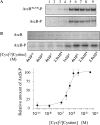Ubiquinone and menaquinone electron carriers represent the yin and yang in the redox regulation of the ArcB sensor kinase
- PMID: 23645604
- PMCID: PMC3697540
- DOI: 10.1128/JB.00406-13
Ubiquinone and menaquinone electron carriers represent the yin and yang in the redox regulation of the ArcB sensor kinase
Abstract
The Arc two-component system, comprising the ArcB sensor kinase and the ArcA response regulator, modulates the expression of numerous genes in response to respiratory growth conditions. Under aerobic growth conditions, the ubiquinone electron carriers were proposed to silence the kinase activity of ArcB by oxidizing two cytosol-located redox-active cysteine residues that participate in intermolecular disulfide bond formation. Here, we confirm the role of the ubiquinone electron carriers as the silencing signal of ArcB in vivo, we show that the redox potential of ArcB is about -41 mV, and we demonstrate that the menaquinols are required for proper ArcB activation upon a shift from aerobic to anaerobic growth conditions. Thus, an essential link in the Arc signal transduction pathway connecting the redox state of the quinone pool to the transcriptional apparatus is elucidated.
Figures




References
-
- Jung WS, Jung YR, Oh DB, Kang HA, Lee SY, Chavez-Canales M, Georgellis D, Kwon O. 2008. Characterization of the Arc two-component signal transduction system of the capnophilic rumen bacterium Mannheimia succiniciproducens. FEMS Microbiol. Lett. 284:109–119 - PubMed
-
- Malpica R, Sandoval GR, Rodriguez C, Franco B, Georgellis D. 2006. Signaling by the Arc two-component system provides a link between the redox state of the quinone pool and gene expression. Antioxid. Redox Signal. 8:781–795 - PubMed
-
- Lynch AS, Lin EC. 1996. Regulation of gene expression in Escherichia coli, p 1526–1538 In Neidhardt FC, Curtis R, Ingraham AL, Lin ECC, Low KB, Magasanik B, Reznikoff WS, Riley M, Schaechter M, Umbarger HE. (ed), Escherichia coli and Salmonella: cellular and molecular biology. American Society of Microbiology, Washington, DC
Publication types
MeSH terms
Substances
LinkOut - more resources
Full Text Sources
Other Literature Sources
Molecular Biology Databases

